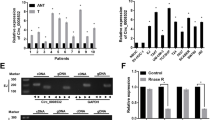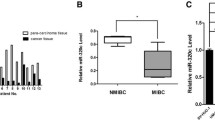Summary
MicroRNAs (miRNAs or miRs) are a class of short, non-coding RNAs that participate in various oncological processes. This study aims to explore the roles of microRNA-34a (miR-34a) in invasive urothelial bladder carcinoma. miR-34a was transfected into bladder cancer cell lines 253J and J82. The miR-34a expression levels in tissues and cells were detected by using qRT-PCR. The Notch1 expression was detected by qRT-PCR and Western blotting. Cell migratory and invasive abilities were measured by Transwell chamber assay. Bioinformatics and luciferase assay were performed to predict and analyze the binding sites between miRNA-34a and Notch1. It was found that there was aberrant expression of miR-34a in bladder cancer tissues. Moreover, we revealed that ectopic expression of miR-34a suppressed cell migration and invasion, while forced expression of Notch1 increased cell migratory and invasive abilities. Finally, we observed that miR-34a transfection significantly down-regulated luciferase activity and reduced the mRNA and protein levels of Notch1. Our study concluded that microRNA-34a antagonizes Notch1 and inhibits cell migration and invasion of bladder cancer cells, which indicates the tumor-suppressive function of microRNA-34a in bladder cancer.
Similar content being viewed by others
References
Jemal A, Bray F, Center MM, et al. Global cancer statistics. CA Cancer J Clin, 2011,61(2):69–90
Filipowicz W, Bhattacharyya SN, Sonenberg N. Mechanisms of post-transcriptional regulation by microRNAs: are the answers in sight? Nat Rev Genet, 2008,9(2):102–114
Yekta S, Shih IH, Bartel DP. MicroRNA-directed cleavage of HOXB8 mRNA. Science, 2004,304(5670): 594–596
Zhang Y, Chao T, Li R, et al. MicroRNA-128 inhibits glioma cells proliferation by targeting transcription factor E2F3a. J Mol Med (Berl), 2009,87(1):43–51
Deng S, Calin GA, Croce CM, et al. Mechanisms of microRNA deregulation in human cancer. Cell Cycle, 2008,7(17):2643–2646
Kong F, Sun C, Wang Z, et al. miR-125b confers resistance of ovarian cancer cells to cisplatin by targeting pro-apoptotic Bcl-2 antagonist killer 1. J Huazhong Univ Sci Technol [Med Sci], 2011,31(4):543–549
Mauviel A. Cytokine regulation of metalloproteinase gene expression. J Cell Biochem, 1993,53(4):288–295
Sporn MB. The war on cancer. Lancet, 1996,347(9012):1377–1381
Lin F, Wang X, Jie Z, et al. Inhibitory effects of miR-146b-5p on cell migration and invasion of pancreatic cancer by targeting MMP16. J Huazhong Univ Sci Technol [Med Sci], 2011,31(4):509–514
Crawford M, Brawner E, Batte K, et al. MicroRNA-126 inhibits invasion in non-small cell lung carcinoma cell lines. Biochem Biophys Res Commun, 2008,373(4): 607–612
Li Y, Guessous F, Zhang Y, et al. MicroRNA-34a inhibits glioblastoma growth by targeting multiple oncogenes. Cancer Res, 2009,69(19):7569–7576
Liu C, Kelnar K, Liu B, et al. The microRNA miR-34a inhibits prostate cancer stem cells and metastasis by directly repressing CD44. Nat Med, 2011,17(2):211–215
Li N, Fu H, Tie Y, et al. miR-34a inhibits migration and invasion by down-regulation of c-Met expression in human hepatocellular carcinoma cells. Cancer Lett, 2009,275(1):44–53
Raver-Shapira N, Marciano E, Meiri E, et al. Transcriptional activation of miR-34a contributes to p53-mediated apoptosis. Mol Cell, 2007,26(5):731–743
Welch C, Chen Y, Stallings RL. MicroRNA-34a functions as a potential tumor suppressor by inducing apoptosis in neuroblastoma cells. Oncogene, 2007,26(34):5017–5022
Miele L, Miao H, Nickoloff BJ. NOTCH signaling as a novel cancer therapeutic target. Curr Cancer Drug Targets, 2006,6(4):313–323
Bolos V, Grego-Bessa J, de la Pompa JL. Notch signaling in development and cancer. Endocr Rev, 2007,28(3): 339–363
Ai X, Zhang XP, Wu Z, et al. Effect of silencing Notch1 on proliferation of bladder cancer cell line T24. J Shandong Univ-Health Sci (Chinese), 2009,47(9):53–57
Bin Hafeez B, Adhami VM, Asim M, et al. Targeted knockdown of Notch1 inhibits invasion of human prostate cancer cells concomitant with inhibition of matrix metalloproteinase-9 and urokinase plasminogen activator. Clin Cancer Res, 2009,15(2):452–459
Wang Z, Banerjee S, Li Y, et al. Down-regulation of notch-1 inhibits invasion by inactivation of nuclear factor-kappaB, vascular endothelial growth factor, and matrix metalloproteinase-9 in pancreatic cancer cells. Cancer Res, 2006,66(5):2778–2784
Chigurupati S, Venkataraman R, Barrera D, et al. Receptor channel TRPC6 is a key mediator of Notch-driven glioblastoma growth and invasiveness. Cancer Res, 2010,70(1):418–427
Wang J, Fu L, Gu F, et al. Notch1 is involved in migration and invasion of human breast cancer cells. Oncol Rep, 2011,26(5):1295–1303
Pang RT, Leung CO, Ye TM, et al. MicroRNA-34a suppresses invasion through downregulation of Notch1 and Jagged1 in cervical carcinoma and choriocarcinoma cells. Carcinogenesis, 2010,31(6):1037–1044
Shi TP, Xu H, Wei JF, et al. Association of low expression of notch-1 and jagged-1 in human papillary bladder cancer and shorter survival. J Urol, 2008,180(1):361–366
Hu Z, Ai Q, Xu H, et al. Fibulin-5 is down-regulated in urothelial carcinoma of bladder and inhibits growth and invasion of human bladder cancer cell line 5637. Urol Oncol, 2011,29(4):430–435
Babashah S, Soleimani M. The oncogenic and tumour suppressive roles of microRNAs in cancer and apoptosis. Eur J Cancer, 2011,47(87):1127–1137
Heijmans BT, Boer JM, Suchiman HE, et al. A common variant of the methylenetetrahydrofolate reductase gene (1p36) is associated with an increased risk of cancer. Cancer Res, 2003,63(6):1249–1253
Matsumoto H, Matsuyama H, Fukunaga K, et al. Allelic imbalance at 1p36 may predict prognosis of chemoradiation therapy for bladder preservation in patients with invasive bladder cancer. Br J Cancer, 2004,91(6):1025–1031
Vinall RL, Zripoll A, Wang S, et al. MiR-34a chemo-sensitizes bladder cancer cells to cisplatin treatment regardless of P53-Rb pathway status. Int J Cancer, 2011,130(11):2526–2538
Gaur A, Jewell DA, Liang Y, et al. Characterization of microRNA expression levels and their biological correlates in human cancer cell lines. Cancer Res, 2007,67(6):2456–2468
Yan D, Zhou X, Chen X, et al. MicroRNA-34a inhibits uveal melanoma cell proliferation and migration through downregulation of c-Met. Invest Ophthalmol Vis Sci, 2009,50(4):1559–1565
Potapova IA, Gaudette GR, Brink PR, et al. Mesenchymal stem cells support migration, extracellular matrix invasion, proliferation, and survival of endothelial cells in vitro. Stem Cells, 2007,25(7):1761–1768
Balint K, Xiao M, Pinnix CC, et al. Activation of Notch1 signaling is required for beta-catenin-mediated human primary melanoma progression. J Clin Invest, 2005,115(11):3166–3176
Willert K, Nusse R. Beta-catenin: a key mediator of Wnt signaling. Curr Opin Genet Dev, 1998,8(1):95–102
Liu H, Chen A, Guo F, et al. Influence of osteopontin short hairpin RNA on the proliferation and invasion of human renal cancer cells. J Huazhong Univ Sci Technol [Med Sci], 2010,30(1):61–68
Delbosc S, Glorian M, Le Port AS, et al. The benefit of docosahexanoic acid on the migration of vascular smooth muscle cells is partially dependent on Notch regulation of MMP-2/-9. Am J Pathol, 2008,172(5):1430–1440
Author information
Authors and Affiliations
Corresponding author
Additional information
This project was supported by a grant from the National Natural Science Foundation of China (No. 30972982).
Rights and permissions
About this article
Cite this article
Zhang, C., Yao, Z., Zhu, M. et al. Inhibitory effects of microRNA-34a on cell migration and invasion of invasive urothelial bladder carcinoma by targeting notch1. J. Huazhong Univ. Sci. Technol. [Med. Sci.] 32, 375–382 (2012). https://doi.org/10.1007/s11596-012-0065-z
Received:
Published:
Issue Date:
DOI: https://doi.org/10.1007/s11596-012-0065-z




